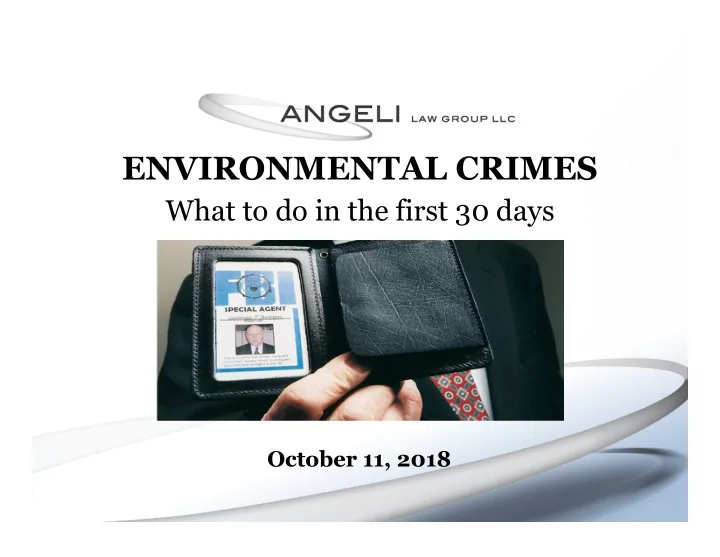

ENVIRONMENTAL CRIMES What to do in the first 30 days October 11, 2018
Today’s Discussion • Background • Step 1: Stopping the Bleeding/Asserting Control • Step 2: Immediate Legal Issues • Step 3: Setting the Stage for Investigation/Trial Preparation
Background • 2009: Oregon DOJ Environmental Crimes Unit Oregon Environmental Crimes Act (1993): • – 6 felony provisions (generally Class B (max 10 yrs., $250K fine)) Actor must have acted “knowingly.” • Act must have violated statute, rule, standard, license, permit, or order. • Act must have recklessly caused substantial harm to human health or the • environment or have been done in knowing disregard of the law. – 5 misdemeanor provisions • No requirement of harm to human health/environment or knowing disregard. – Affirmative Defenses: • Bypass • Upset • Didn’t create the condition, reported immediately, took steps to correct. – Felony Prosecutorial Guidelines
Background • How a criminal case can be initiated: – Referral from DEQ, city regulators, etc. – Indictment – Search warrant – Grand Jury subpoena – Target/subject letter
Today’s Discussion • Background • Step 1: Stopping the Bleeding/Asserting Control • Step 2: Immediate Legal Issues • Step 3: Setting the Stage for Investigation/Trial Preparation
Asserting Control – Presence at Search Warrant Execution • Large team of armed agents swarms the premises. • Frequently federal (e.g., EPA’s Eric Martenson) and state (e.g., OSP’s Craig Ball) presence. • Secure entrances and exits. – Nobody let in or out. • Computers, trade secrets and privileged materials may be taken. • Agents will attempt to interview employees. • Process will take the entire day.
Asserting Control – Presence at Search Warrant Execution • Make contact with law enforcement (lead agent) ASAP. – Employees allowed to leave. – No contact with upper management. – Obtain a copy of the search warrant and understand scope. – Make efforts to preserve privilege. • Stay onsite. – Prioritize business necessities. – Obtain receipt/inventory.
Asserting Control – Preservation of Evidence • Litigation hold. • Understand what was seized. – Search warrant inventory – Debrief interviewed parties. • Identify key players and gather documents. • Request copies of documents from the government.
Asserting Control – Rights and Obligations • May not advise employees not to talk to law enforcement. – But may advise them that they are not required to talk to law enforcement. – And of their right to have counsel present if they agree to be interviewed. • May advise management not to speak with law enforcement without counsel. • If someone talks, must be 100% honest.
Asserting Control – Parallel Cases • Implications for discovery obligations. • Pleading the Fifth (for individuals). • Potential benefits of civil discovery.
Asserting Control – Business and Media Plan • Can the company survive? • Are immediate changes necessary? – Policies/practices – Personnel • Reassure employees. • Engaging with the press: – Control the message. – Don’t get over your skis.
Today’s Discussion • Background • Step 1: Stopping the Bleeding/Asserting Control • Step 2: Immediate Legal Issues • Step 3: Setting the Stage for Investigation/Trial Preparation
Legal Issues – Filter Process • Government may not review privileged information. • Set parameters of filter process with AUSA/DDA: – List of counsel used by company – Search terms – Procedures before passing to prosecution team
Legal Issues – Government’s Theory GOAL: Identify the potential charges. • Talk to the prosecutor. • Review any documentation: – Indictment – Subpoena – Search warrant affidavit (if unsealed) • Talk to any interviewed employees.
Legal Issues – Early Motion Practice • Challenges to the charging instrument: – Higher bar than 12(b)(6). – State court: must generally be made at or near time of arraignment (except for good cause). • Challenges to the search: – Not supported by probable cause. – Search exceeded the scope of the warrant. – Criminal search masquerading as an “administrative” search? • Challenges to interviews – Custodial interrogation? – Violations of the no-contact rule?
Legal Issues – Sentencing Analysis GOAL: Identify exposure to drive strategic decisions. • Statutory maximums: – Prison/fines (for individuals) – Fines (for company) • Federal Sentencing Guidelines • Analysis of similar cases
Today’s Discussion • Background • Step 1: Stopping the Bleeding/Asserting Control • Step 2: Immediate Legal Issues • Step 3: Setting the Stage for Investigation/Trial Preparation
Step 3: Setting the Factual Stage – Learning the government narrative • Meeting with the prosecutor (“reverse proffer”) • Public records requests • Discovery demand – Brady material – Witness statements – Government exhibits – Witness list • Brown/O’Key motions
Step 3: Setting the Factual Stage – Developing the Defense Narrative • Interviews – Anyone interviewed by the government – Key players – Management • Third-party subpoenas • Document collection/review • Experts
QUESTIONS?
Recommend
More recommend